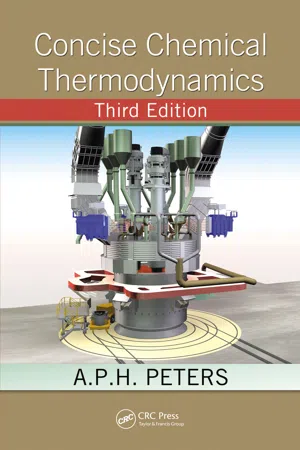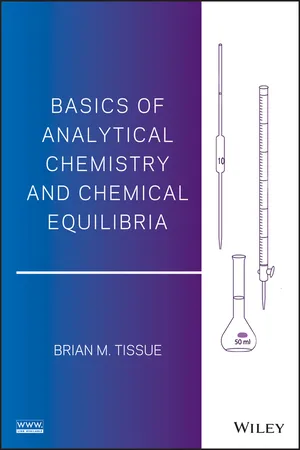Chemistry
Cell Potential and Free Energy
Cell potential is a measure of the ability of a chemical reaction to produce an electric current. It is related to the free energy change of the reaction, which indicates whether the reaction is spontaneous or non-spontaneous. The relationship between cell potential and free energy is described by the equation ΔG = -nFE, where ΔG is the change in free energy, n is the number of moles of electrons transferred, F is Faraday's constant, and E is the cell potential.
Written by Perlego with AI-assistance
Related key terms
4 Key excerpts on "Cell Potential and Free Energy"
- eBook - ePub
Physical Chemistry
How Chemistry Works
- Kurt W. Kolasinski(Author)
- 2016(Publication Date)
- Wiley(Publisher)
For example, for Eq. (15.79) (15.82) A reaction producing H + has a value of E ° less than E °' by 0.414 V/ z per mole of H + formed, and is more spontaneous at pH 7 than at pH 0. Note that corrections of this type only need to be made when trying to compare values of standard electrode potentials from one scale to the other, or when calculations of expected cell potentials must be constructed by using standard potentials from both scales. 15.8.2 Gibbs energy change in terminal respiratory cycle The conversion of nicotinamide adenine dinucleotide, reduced form (NADH) to its oxidized form (NAD +) releases two electrons, which are used to reduce O 2 to H 2 O. The half-reactions involved are and which corresponds to the overall reaction The Gibbs energy change is Energy can effectively be stored by running an endothermic reaction, such as ATP synthesis (Δ r G°' = 31.4 kJ mol –1). Remember that energy is not released by breaking bonds. Rather, it is released when high-enthalpy species are transformed into lower-enthalpy species via chemical reactions, when weak bonds are replaced by stronger bonds. If the above electron transfers were performed in one step, much energy would be lost as heat. Performing it in a number of steps involving NADH, flavin adenine dinucleotide (FAD), cytochrome b, cytochrome c as well as cytochrome a and cytochrome a 3, releases the energy in smaller steps. This allows for the synthesis of several molecules of ATP along the way in a highly efficient manner, with minimal losses to heat generation. 15.8.3 Membrane potentials Nerve cells and muscle cells are excitable. They can transmit a change of electrical potential along their membranes. The electrical potential established by the difference in ionic concentrations across the membrane is known as the membrane potential. Differences in ionic concentrations inside and outside the cell can be established because the cell membrane has different permeabilities for different ions - eBook - ePub
- A.P.H. Peters(Author)
- 2010(Publication Date)
- CRC Press(Publisher)
9 Electrochemical Cells Her own mother lived the latter years of her life in the horrible suspicion that electricity was dripping invisibly all over the house. (James Thurber, My Life and Hard Times) In fact, James Thurber’s grandmother was partly right; many of the chemical processes occurring around us involve the movement of charged ions in liquids, as well as of electrons in metals. As examples, many corrosion processes arise when aqueous electrolytes are in contact with iron, steel or copper, and battery-powered appliances are common. Electrochemical cells give valuable thermodynamic information, as well as being useful in their own right. Measurements of cell electromotive force (e.m.f.) yield free energy changes directly, and tabulations of electrode potentials provide an alternative source of free energy data. Variations of e.m.f. with concentration lead to a better understanding of activities, and we shall also see how to measure entropy changes from the variation of cell e.m.f. with temperature. 9.1 ELECTROCHEMICAL CELLS A cell is a device for harnessing the energy of a chemical process to do electrical work, directly. A cell e.m.f. is available at the electrodes, which are immersed in, or in contact with, the electrolyte in which charged species, ions, are mobile. If a bar of zinc is dipped into a diluted solution of zinc sulfate, some zinc ions, Zn 2+, dissolve, leaving two electrons each on the metal. This causes a separation of charge, and eventually (Figure 9.1) equilibrium is achieved. An electrical double layer forms, which consists of electrons on the metal surface and zinc ions immediately adjacent to it. At this stage, the tendency to dissolve is exactly matched by the tendency of zinc ions to deposit, which is caused by the charge separation. This means that there is a potential difference between metal and solution, which, however, cannot be measured - eBook - ePub
- Ryan O'Hayre, Suk-Won Cha, Whitney Colella, Fritz B. Prinz(Authors)
- 2016(Publication Date)
- Wiley(Publisher)
indicates whether or not a reaction is spontaneous:- Nonspontaneous (energetically unfavorable)
- Equilibrium
- Spontaneous (energetically favorable)
A spontaneous reaction is energetically favorable; it is a “downhill” process. Although spontaneous reactions are energetically favorable, spontaneity is no guarantee that a reaction will occur, nor does it indicate how fast a reaction will occur. Many spontaneous reactions do not occur because they are impeded by kinetic barriers. For example, at STP, the conversion of diamond to graphite is energetically favorable . Fortunately for diamond lovers, kinetic barriers prevent this conversion from occurring. Fuel cells, too, are constrained by kinetics. The rate at which electricity can be produced from a fuel cell is limited by several kinetic phenomena. These phenomena are covered in Chapters 3 –5 . Before we get to kinetics, however, you need to understand how the electrical work capacity of a fuel cell is translated into a cell voltage.2.3.4 Relationship between Gibbs Free Energy and Voltage
The potential of a system to perform electrical work is measured by voltage (also called electrical potential). The electrical work done by moving a charge Q, measured in coulombs, through an electrical potential difference E in volts isIf the charge is assumed to be carried by electrons, then2.572.58where n is number of moles of electrons transferred and F is Faraday's constant. Combining Equations 2.57 , and 2.58 yieldsThus, the Gibbs free energy sets the magnitude of the reversible voltage for an electrochemical reaction. For example, in a hydrogen–oxygen fuel cell, the reaction2.592.60has a Gibbs free-energy change of –237 kJ/mol under standard-state conditions for liquid water product. The reversible voltage generated by a hydrogen–oxygen fuel cell under standard-state conditions is thus - Brian M. Tissue(Author)
- 2013(Publication Date)
- Wiley(Publisher)
8.5 Reaction Energies, Voltages, and the Nernst Equation Reactants that are mixed in nonequilibrium concentrations have chemical potential energy that drives the reaction toward equilibrium. This potential energy is the difference in Gibbs energy between the products and reactants,. The reactants will react to achieve equilibrium and reach a lower energy condition. For any set of reactant and product concentrations, is given by 8.1 where Δ G ° is the difference in Gibbs energy at standard concentrations is the gas constant (8.3145 J/mol K) is absolute temperature (K) is the reaction quotient. (has the same form as any equilibrium constant expression, but the different symbol, vs, is used to indicate that the concentrations or partial pressures are not equilibrium values.) This relationship shows that reactants at concentrations far from equilibrium will have greater Gibbs energy than reactants near equilibrium concentrations. At equilibrium,. We cannot extract energy from a system at equilibrium. In addition, note that 8.2 That these two quantities, Δ G ° and, are related should make sense. tells us the relative concentrations of products to reactants at equilibrium, and Δ G ° tells us how much energy we could get out of a reaction when they are at standard concentrations, that is, not at equilibrium concentrations. E ° and Δ G ° and (or Δ G ° and E ° for standard concentrations) are both measures of the driving force of spontaneous reactions. The following relationships are given without proof: 8.3 8.4 where is the number of moles of electrons transferred and is the Faraday constant. The Faraday constant is the charge of one electron times the number of electrons per mole: You will also see it with equivalent units of 96485.3 J/(mol V)
Learn about this page
Index pages curate the most relevant extracts from our library of academic textbooks. They’ve been created using an in-house natural language model (NLM), each adding context and meaning to key research topics.



